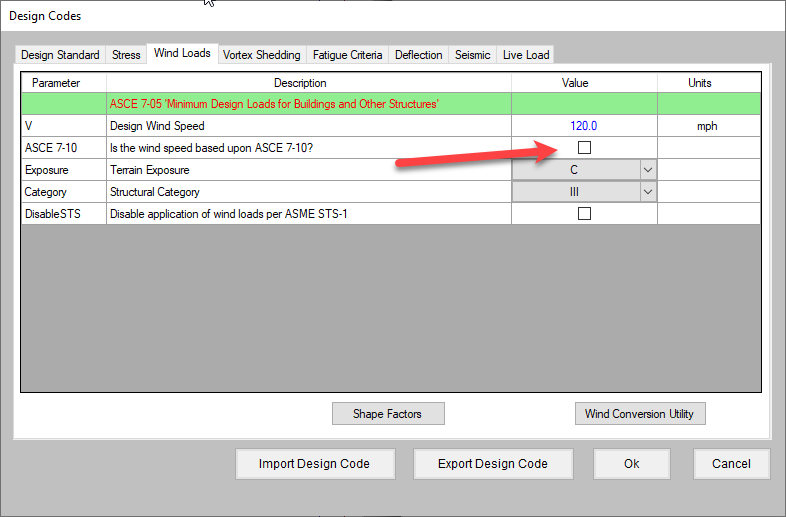Note: This article is related to ASME STS-1-2016, and that standard has been since replaced by ASME STS-1-2021. Here is more information on ASME STS-1-2021
If the user specifies ASME STS-1-2016, then that code is based upon ASCE 7-05. The most recent release, ASME STS-1-2016, has an option to consider wind speeds per ASCE 7-10. If this option is selected, then the winds are converted to an equivalent wind speed in ASCE 7-05 and then the analysis is performed as usual following ASCE 7-05. The conversion is as follows:

Once the wind speed is converted to an equivalent wind speed in ASCE 7-05, because ASCE 7-10 is based upon ultimate wind speeds and ASCE 7-05 is based upon Working wind speeds, then the analysis is performed just as it would have been using ASCE 7-05. This is accomplished in the software using the below check box, when the box is checked then the wind speed "V" is assumed to be based upon ASCE 7-10 and converted using the above Equation 4-5.

Now there is a new version of ASCE 7-16 that has been released; however, ASME STS-1 still only refers to ASCE 7-10/05. For all practical purposes, for a stack the wind per ASCE 7-16 is the same as ASCE 7-10. The main difference for stacks is the consideration of a new factor "Ke", which allows the user to reduce the pressure at higher elevations where the air is thinner. This factor only decreases the wind relative to the pressures calculated per ASCE 7-10 (At high elevations); therefore, it is conservative to use ASCE 7-10 and say that is is "Equivalent" to ASCE 7-16.
There is another option to run a True ASCE 7-16 analysis. It requires that you enter a special section of the software for "Customized" codes. When this is selected you can use ASCE 7-16 for wind; however, now we are not following ASME STS-1, and so the load combinations are different.

There is a special hidden feature in MecaStack called Customized, which allows you to enter customized combinations of codes. We discourage its use, because it is problematic. However, sometimes it is the only way to run a certain combination of codes.
Customized Codes:
I have hidden the customized option so that it’s not so readily available, because I have seen it misused so often. I fear that it’s a safety issue. If the client specifies inconsistent codes (one for along wind and another for across wind) in my opinion it’s really better to make two different MecaStack runs, and have one run specifically for along and the other for across wind. This way you know exactly what “equivalent” along wind is being assumed for the across wind, rather than having the software attempt to do it for you.
If this won't work for you, then the customized option is available when <Ctrl> C is pressed on the design code form.

